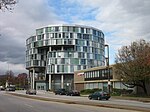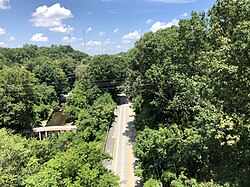Reservoir Hill, Baltimore
Baltimore National Heritage AreaHistoric districts in BaltimoreHistoric districts on the National Register of Historic Places in MarylandHouses in BaltimoreHouses on the National Register of Historic Places in Baltimore ... and 11 more
Jewish communities in the United StatesJews and Judaism in BaltimoreNRHP infobox with nocatNeighborhoods in BaltimoreReservoir Hill, BaltimoreRussian-Jewish culture in BaltimoreRussian communities in the United StatesUkrainian-American culture in BaltimoreUkrainian communities in the United StatesUse mdy dates from August 2023Victorian architecture in Maryland

Reservoir Hill, is a historic neighborhood in the city of Baltimore, Maryland, United States. It is located south of Druid Hill Park, north of Bolton Hill, east of Penn-North, and west of Jones Falls. It is bounded by Druid Park Lake Drive, the Jones Falls Expressway, North Avenue (U.S. Route 1), and McCulloh Street. It is contained in the 21217 ZIP code.
Excerpt from the Wikipedia article Reservoir Hill, Baltimore (License: CC BY-SA 3.0, Authors, Images).Reservoir Hill, Baltimore
Brookfield Avenue, Baltimore
Geographical coordinates (GPS) Address Nearby Places Show on map
Geographical coordinates (GPS)
| Latitude | Longitude |
|---|---|
| N 39.315 ° | E -76.633333333333 ° |
Address
Brookfield Avenue 2409
21217 Baltimore
Maryland, United States
Open on Google Maps









